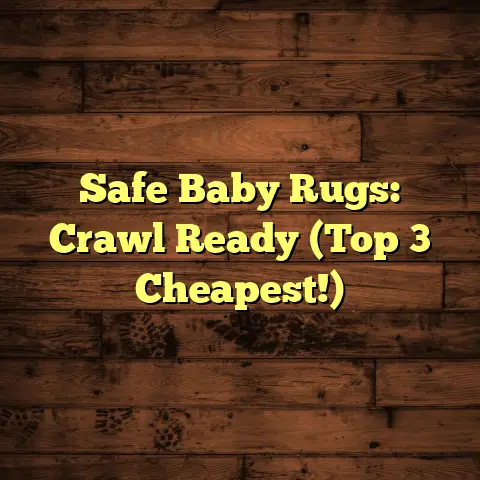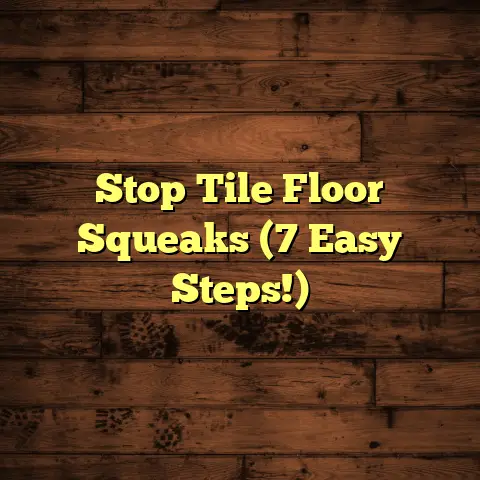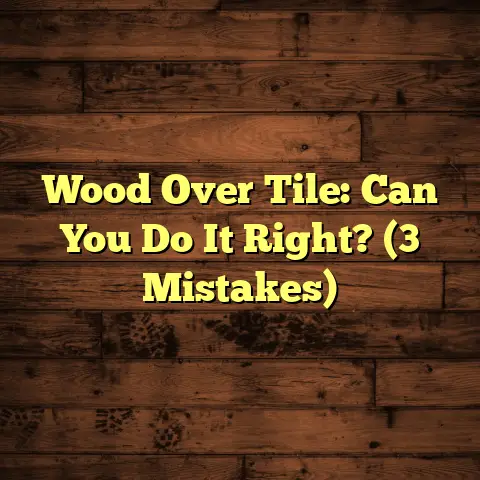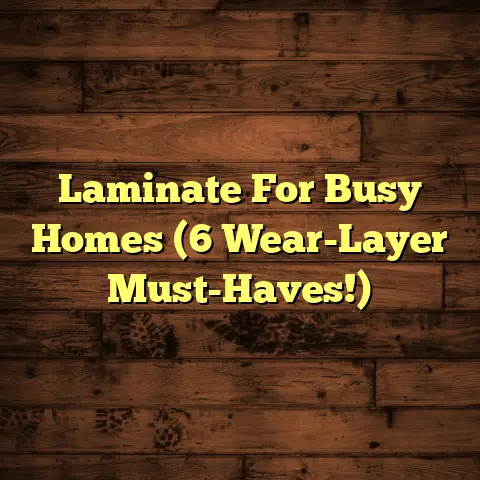Clean Wood After Carpet? (4 Finish Busters!)
As a flooring contractor, I’ve seen it all.
And let me tell you, one of the most common questions I get is about cleaning wood floors after ripping out old carpet.
Trust me, I get it. You’re excited to uncover that beautiful hardwood, but you’re also probably staring at a dusty, grimy mess. Don’t worry, I’m here to help!
We’re diving into the essential steps to clean your wood floors after carpet removal. I will share the top 4 “Finish Busters” to tackle leftover dust, dirt, and allergens.
But first, let’s talk about why this is so important.
1. Understanding Allergies and Indoor Air Quality
Did you know that allergies are on the rise?
According to the Asthma and Allergy Foundation of America (AAFA), more than 50 million Americans experience allergies each year. (Source: aafa.org)
That’s a lot of sneezing, itching, and watery eyes!
And guess what? Your home could be a major contributor.
Think about it: dust mites, mold spores, pet dander, and other allergens love to hide in carpets.
Even with regular vacuuming, these tiny irritants can become deeply embedded, triggering allergic reactions and impacting your overall indoor air quality.
That’s why many people are making the switch from carpet to wood flooring. Wood floors are much easier to clean and don’t trap allergens the same way carpets do.
But here’s the catch: simply removing the carpet isn’t enough. You need to thoroughly clean those wood floors to get rid of all the hidden nasties.
2. The Importance of Cleaning Wood Floors Post-Carpet Removal
So, why is cleaning so crucial after carpet removal?
Well, imagine all the dust, dirt, and allergens that have been accumulating in your carpet for years. When you rip that carpet out, all that stuff gets stirred up and settles onto your wood floors. Yuck!
If you don’t clean properly, you’re just walking around spreading those allergens, and you might as well have left the carpet!
Beyond the allergy factor, a good cleaning can also rejuvenate your wood floors.
Over time, dirt and grime can dull the finish and make your floors look tired. A thorough cleaning can restore their shine and bring back their natural beauty.
Plus, cleaning helps protect your investment. By removing abrasive particles, you’re preventing scratches and wear that can damage the finish over time.
Trust me, a little elbow grease now can save you a lot of money on repairs or refinishing down the road.
3. Finish Buster #1: Deep Cleaning with Vinegar and Water Solution
Okay, let’s get down to business!
My first “Finish Buster” is a classic for a reason: a vinegar and water solution. It’s cheap, it’s effective, and it’s safe for most wood finishes.
But before you go dumping vinegar all over your floors, here’s the right way to do it.
Step-by-Step Guide:
-
Gather your supplies: You’ll need white vinegar, water, a bucket, a mop (microfiber is best), and a vacuum or broom.
-
Vacuum or sweep: Before you start mopping, remove any loose debris from the floor. This will prevent you from just pushing dirt around.
-
Mix your solution: The key is to use the right ratio of vinegar to water.
I recommend 1/2 cup of white vinegar per gallon of water. Too much vinegar can damage the finish, so don’t overdo it!
-
Mop the floor: Dip your mop into the solution, wring it out thoroughly, and mop the floor in sections.
Make sure the mop is damp, not soaking wet. Excess water can seep into the seams and damage the wood.
-
Rinse the mop frequently: As you mop, the water will get dirty. Rinse the mop frequently to avoid spreading the grime around.
-
Dry the floor: Once you’ve mopped the entire floor, use a clean, dry towel to wipe up any excess water. This will help prevent water spots and streaks.
Benefits of Vinegar and Water:
-
Natural and non-toxic: Vinegar is a natural disinfectant and deodorizer, and it won’t leave behind any harmful residues.
-
Effective at cutting through grime: The acidity of vinegar helps to dissolve dirt, grease, and other buildup.
-
Affordable: Vinegar is much cheaper than commercial wood floor cleaners.
Important Note: Always test the solution in an inconspicuous area first to make sure it doesn’t damage the finish. And never use vinegar on waxed wood floors, as it can strip the wax.
4. Finish Buster #2: Baking Soda for Stain Removal
Okay, so you’ve got some stubborn stains that the vinegar and water just won’t budge?
That’s where baking soda comes in!
Baking soda is a mild abrasive that can help lift stains without damaging the wood finish.
How to Use Baking Soda for Stain Removal:
-
Make a paste: Mix baking soda with just enough water to form a thick paste.
-
Apply the paste: Apply the paste to the stain and gently rub it in with a soft cloth.
-
Let it sit: Let the paste sit on the stain for 30 minutes to an hour.
-
Rinse and dry: Rinse the area with a damp cloth and dry it thoroughly with a clean towel.
Tips for Using Baking Soda:
-
Don’t scrub too hard: You want to lift the stain, not scratch the finish. Use a gentle touch.
-
Test in an inconspicuous area: As with the vinegar solution, test the baking soda paste in an inconspicuous area first to make sure it doesn’t damage the finish.
-
Use it for specific stains: Baking soda is best for localized stains, such as water spots, pet stains, or food spills. It’s not ideal for cleaning the entire floor.
5. Finish Buster #3: Commercial Wood Floor Cleaners
Sometimes, you need a little extra cleaning power.
That’s where commercial wood floor cleaners come in.
But with so many options on the market, how do you choose the right one?
Key Considerations:
-
Read the label: Make sure the cleaner is specifically designed for wood floors. Avoid products that contain harsh chemicals, such as ammonia or bleach, as these can damage the finish.
-
Look for pH-neutral cleaners: pH-neutral cleaners are gentle on wood finishes and won’t leave behind any residue.
-
Consider your allergies: If you have allergies, look for fragrance-free and hypoallergenic cleaners.
Popular Brands:
Here are a few popular brands that I often recommend:
-
Bona: Bona is a well-known brand that offers a range of wood floor cleaning products, including cleaners, polishes, and mops.
Their cleaners are pH-neutral and water-based, making them safe for most wood finishes.
Many of my clients swear by Bona and it is my personal favorite.
-
Murphy Oil Soap: Murphy Oil Soap is a classic cleaner that can be used on wood floors, furniture, and other surfaces.
It’s made with natural ingredients and has a pleasant scent. However, it can leave behind a residue if not used properly, so be sure to follow the instructions carefully.
-
Method: Method offers a range of eco-friendly cleaning products, including a wood floor cleaner.
Their cleaner is plant-based and biodegradable, making it a good choice for environmentally conscious consumers.
Important Note: Always follow the manufacturer’s instructions when using commercial wood floor cleaners. And test the cleaner in an inconspicuous area first to make sure it doesn’t damage the finish.
6. Finish Buster #4: Essential Oils for Natural Freshness
Want to add a little extra freshness to your wood floors?
Essential oils can be a great way to do it!
Not only do they smell amazing, but some essential oils also have antibacterial and antifungal properties.
Best Essential Oils for Wood Floors:
-
Tea Tree Oil: Tea tree oil has antiseptic and antifungal properties, making it a great choice for killing germs and freshening your floors.
-
Lavender Oil: Lavender oil has a calming and relaxing scent, and it also has antibacterial properties.
-
Lemon Oil: Lemon oil has a bright, citrusy scent, and it can also help to cut through grease and grime.
How to Use Essential Oils on Wood Floors:
-
Dilute the oil: Never apply essential oils directly to your wood floors, as they can damage the finish.
Always dilute them with water or a carrier oil, such as jojoba oil or almond oil.
-
Add to your cleaning solution: Add a few drops of essential oil to your vinegar and water solution or your commercial wood floor cleaner.
-
Create a refreshing spray: Mix a few drops of essential oil with water in a spray bottle and spritz it onto your floors after cleaning.
Important Note: Be careful when using essential oils around pets, as some oils can be toxic to animals. Always do your research before using essential oils around your furry friends.
7. Conclusion: The Path to Cleaner Air and Healthier Living Spaces
So, there you have it! My top 4 “Finish Busters” for cleaning wood floors after carpet removal.
By following these steps, you can remove all the dust, dirt, and allergens that have been hiding in your carpet and create a cleaner, healthier living space for you and your family.
Remember, clean floors are about more than just aesthetics. They’re about improving your indoor air quality and protecting your health.
So, roll up your sleeves, grab your cleaning supplies, and get to work! Your wood floors (and your lungs) will thank you for it.
And if you have any questions or need help with your flooring project, don’t hesitate to reach out to a professional flooring contractor.
We’re always here to help!





